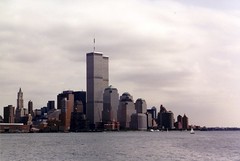The original World Trade Center was a complex of seven buildings, comprising of 13.4 million square feet of office space (almost 4% of Manhattan's entire office inventory). All of the original buildings in the complex were destroyed in the September 11, 2001, attacks: 1 WTC, 2 WTC (North and South Towers) and 7 WTC collapsed; 3 WTC (Marriott Hotel) was crushed by the collapses of 1 WTC and 2 WTC; and 4 WTC, 5 WTC, and 6 WTC were damaged beyond repair and later demolished.
The concept of a World Trade Center complex originated with Nelson and David Rockefeller in the 1950s as an attempt to revitalize lower Manhattan. The initial proposed site on the East River was later moved to the lower west side. The complex towers were designed by Minoru Yamasaki with Antonio Brittiochi in one of the most striking American implementations of the architectural ethic of Le Corbusier, as well as the seminal expression of Yamasaki's gothic modernist tendencies.
In 1966, construction began under the Port Authority of New York and New Jersey with a groundbreaking that razed 13 square blocks of low rise buildings, some of which predated the US Civil War. In December 1970, tenants moved into One World Trade Center. Tenants first moved into Two World Trade Center in January 1972, followed by a ribbon-cutting ceremony on April 4, 1973.
Although the towers became a New York icon, they were not without their flaws. Initially conceived as a complex dedicated to organizations directly involved in "world trade," they failed to attract the anticipated clientele, instead housing various governmental organizations initially. It wasn't until the 1980s when an increasing number of private companies--mostly Wall Street firms--became tenants. The trade center's "superblock", which replaced a more traditional, dense neighborhood, was regarded by many critics as an inhospitable environment that disrupted the intricate flows of traffic typical of Manhattan.
Still, the Towers had their admirers. For those who deemed it cold and sterile, there were just as many who appreciated its sheer immensity. Each of the twin towers had 110 stories. 1 WTC (the North Tower, which featured a massive 360 ft high TV antenna, added in 1978, and the highest restauarant in the world--"Windows on the World) stood 1,368 feet (417 m) high, and 2 WTC (the South Tower, which contained the observation deck) was 1,362 feet (415 m) high. The length and breadth of the towers were 208 feet (63.4 m) x 208 feet (63.4 m). When completed, 1 WTC became the tallest building in the world, unseating the Empire State Building, and 2 WTC became the 2nd tallest. This was a briefly held title, though, as the 1450 foot Sears Tower was already being constructed. On any given day, some 50,000 people worked in the towers with another 200,000 passing through as visitors.
What the towers lacked in architectural aestheticism, they made up for with engineering innovation. Faced with the difficulties of building to unprecedented heights, chief engineer Leslie Robertson employed an innovative structural model: a rigid "hollow tube" of closely spaced steel columns with floor trusses extending across to a central core. The columns, finished with a silver-colored aluminum alloy, were 18 3/4" wide and set only 22" apart, making the towers appear from afar to have no windows at all. Also unique to the engineering design were its core and elevator system. It was the first to use sky lobbies--floors where commuters can switch from an express elevator to a local elevator. The local elevators were stacked on top of each other within the same shaft. Worried that the intense air pressure created by the buildings' high speed elevators might buckle conventional shafts, engineers designed a solution using a drywall system fixed to the reinforced steel core.

Fresh Trading News For You
Categories
- Forex (14)
- International (20)
- Tips And Tricks (5)
Blog Archive
Fresh News
Template by Isnaini Dot Com
